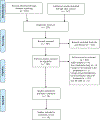The Role of Caregiver Psychopathology in the Treatment of Childhood Trauma with Trauma-Focused Cognitive Behavioral Therapy: A Systematic Review
- PMID: 30796672
- PMCID: PMC8075046
- DOI: 10.1007/s10567-019-00290-4
The Role of Caregiver Psychopathology in the Treatment of Childhood Trauma with Trauma-Focused Cognitive Behavioral Therapy: A Systematic Review
Abstract
Trauma-focused cognitive behavioral therapy (TF-CBT) is regarded as one of the most effective treatments for children who have experienced trauma and is rapidly being disseminated. To best ensure efficacy, even among treatment refractory symptoms, a better understanding of the factors that lead TF-CBT to be more or less effective for some children is warranted. One major factor that has not been systematically considered is the role of caregiver psychopathology. Therefore, this systematic review of 18 empirical studies examined how TF-CBT has incorporated caregiver psychopathology into the treatment of childhood trauma and how it is related to treatment outcomes. The results of this review provide preliminary support for TF-CBT decreasing caregiver psychopathology, in terms of symptoms of depression, PTSD, and emotional distress related to the child's experience of trauma, as well as partial support for caregiver depression, rather than caregiver PTSD or distress, influencing child treatment outcomes. It also illuminates the strong need for future TF-CBT studies to routinely measure caregiver psychopathology. Several recommendations are provided to ensure that the emerging research base can inform clinical practice guidelines on how to incorporate caregivers who exhibit psychopathology and potentially develop modifications to the existing treatment to address trauma and symptoms in both members of the caregiver-child dyad, when needed.
Keywords: Caregiver psychopathology; Child trauma; Systematic review; Trauma-focused cognitive behavioral therapy.
Conflict of interest statement
Figures
Similar articles
-
Caregiver satisfaction with their child's trauma-focused cognitive behavioral therapy.Psychol Trauma. 2021 May;13(4):476-485. doi: 10.1037/tra0000834. Epub 2020 Oct 1. Psychol Trauma. 2021. PMID: 33001670
-
Trauma-Focused Cognitive Behavioral Therapy for Childhood Traumatic Separation.Child Abuse Negl. 2019 Jun;92:179-195. doi: 10.1016/j.chiabu.2019.03.006. Epub 2019 Apr 15. Child Abuse Negl. 2019. PMID: 30999167
-
In-session caregiver behavior predicts symptom change in youth receiving trauma-focused cognitive behavioral therapy (TF-CBT).J Consult Clin Psychol. 2016 Dec;84(12):1066-1077. doi: 10.1037/ccp0000147. Epub 2016 Sep 12. J Consult Clin Psychol. 2016. PMID: 27618641 Free PMC article.
-
Trauma-Focused Cognitive-Behavioral Therapy: The role of caregivers.J Affect Disord. 2020 Dec 1;277:39-45. doi: 10.1016/j.jad.2020.07.123. Epub 2020 Aug 5. J Affect Disord. 2020. PMID: 32791391 Review.
-
Trauma-focused cognitive-behavioral therapy for children and adolescents: assessing the evidence.Psychiatr Serv. 2014 May 1;65(5):591-602. doi: 10.1176/appi.ps.201300255. Psychiatr Serv. 2014. PMID: 24638076 Free PMC article. Review.
Cited by
-
Bidirectional effects of parental and adolescent symptom change in trauma-focused cognitive behavioral therapy.Psychol Trauma. 2023 May;15(Suppl 1):S172-S182. doi: 10.1037/tra0001445. Epub 2023 Feb 27. Psychol Trauma. 2023. PMID: 36848057 Free PMC article.
-
A Systematic Review Focusing on Psychotherapeutic Interventions that Impact Parental Psychopathology, Child Psychopathology and Parenting Behavior.Clin Child Fam Psychol Rev. 2021 Sep;24(3):579-598. doi: 10.1007/s10567-021-00355-3. Epub 2021 Jul 12. Clin Child Fam Psychol Rev. 2021. PMID: 34254219 Free PMC article.
-
Caregiver Behaviors and Child Distress in Trauma Narration and Processing Sessions of Trauma-Focused Cognitive Behavioral Therapy (TF-CBT).Behav Ther. 2022 Jan;53(1):64-79. doi: 10.1016/j.beth.2021.06.001. Epub 2021 Jun 10. Behav Ther. 2022. PMID: 35027159 Free PMC article. Clinical Trial.
-
Posttraumatic Stress Disorder and the Developing Adolescent Brain.Biol Psychiatry. 2021 Jan 15;89(2):144-151. doi: 10.1016/j.biopsych.2020.06.001. Epub 2020 Jun 10. Biol Psychiatry. 2021. PMID: 32709416 Free PMC article. Review.
-
Child and parent secondary outcomes in stepped care versus standard care treatment for childhood trauma.J Affect Disord. 2022 Jun 15;307:87-96. doi: 10.1016/j.jad.2022.03.049. Epub 2022 Mar 21. J Affect Disord. 2022. PMID: 35331823 Free PMC article. Clinical Trial.
References
-
- Banyard VL, Englund DW, & Rozelle D (2001). Parenting the traumatized child: Attending to the needs of nonoffending caregivers of traumatized children. Psychotherapy, 38, 74–87. 10.1037/0033-3204.38.1.74. - DOI
-
- Beck AT, Rush AT, Shaw BF, & Emery G (1979). Cognitive therapy of depression. New York: Guilford Press.
-
- Beck AT, Steer RA, & Brown GK (1996). Manual for the Beck Depression Inventory II. San Antonio, TX: Psychological Corporation.
Publication types
MeSH terms
Grants and funding
LinkOut - more resources
Full Text Sources
Medical
Miscellaneous


